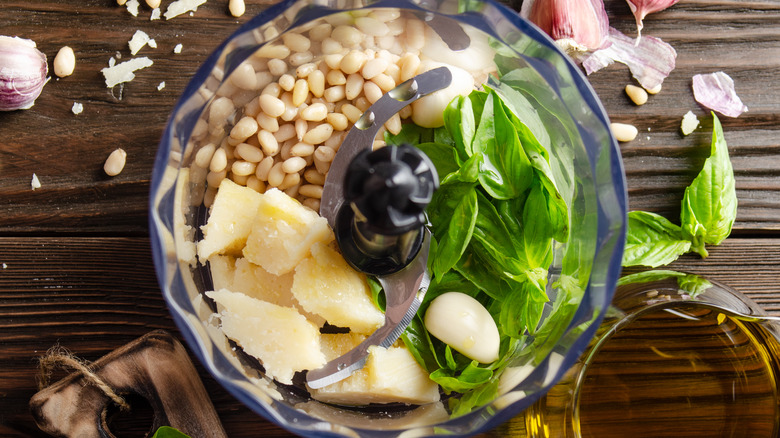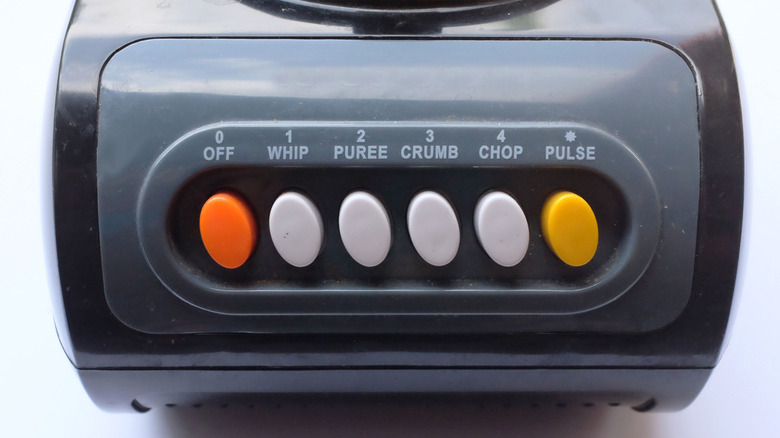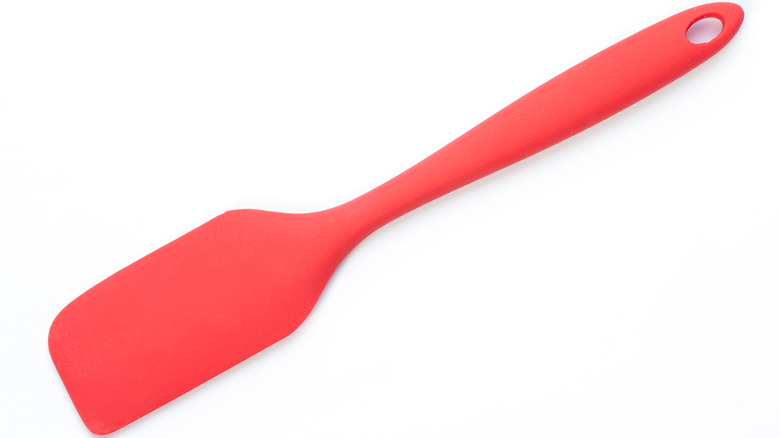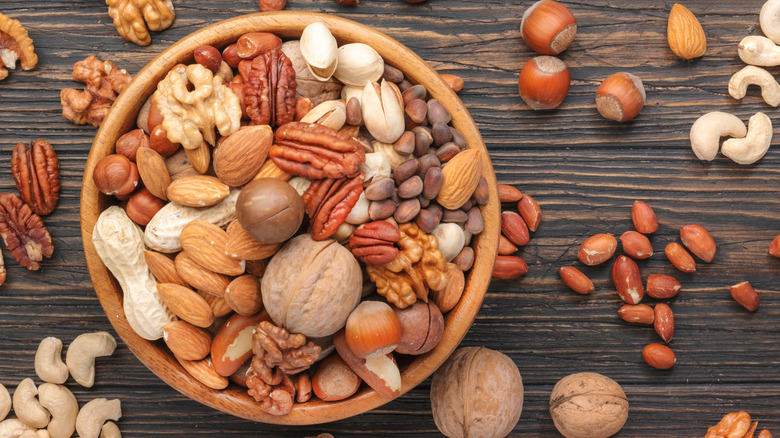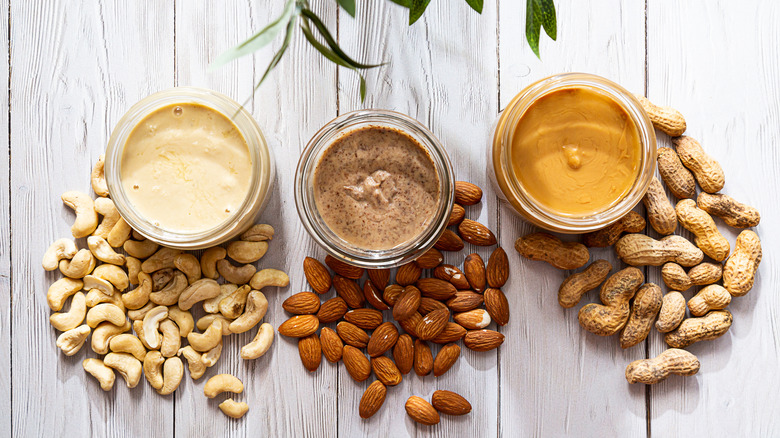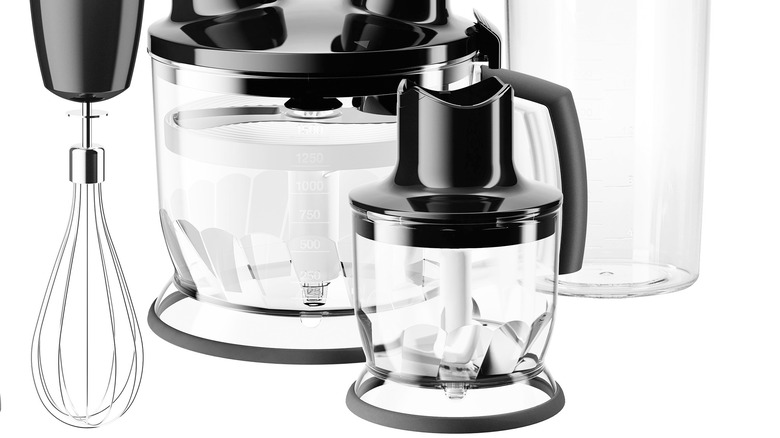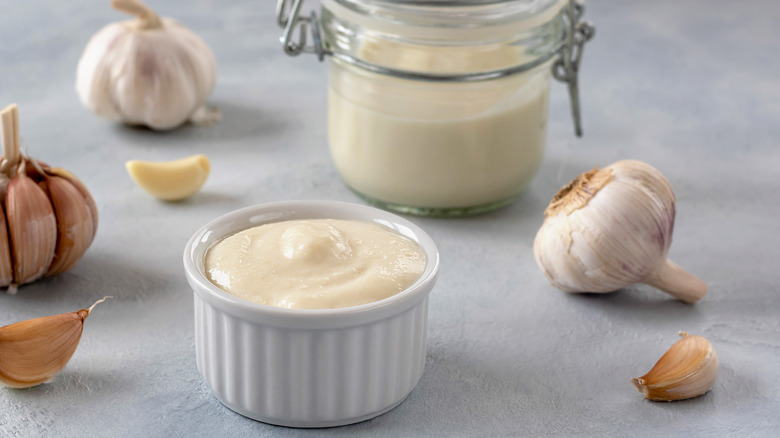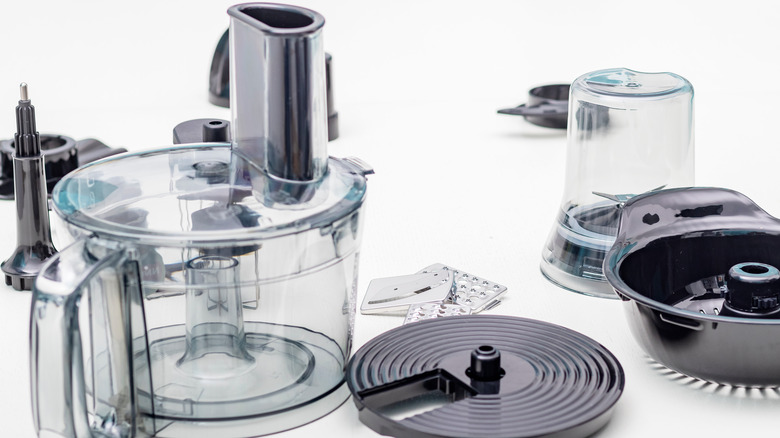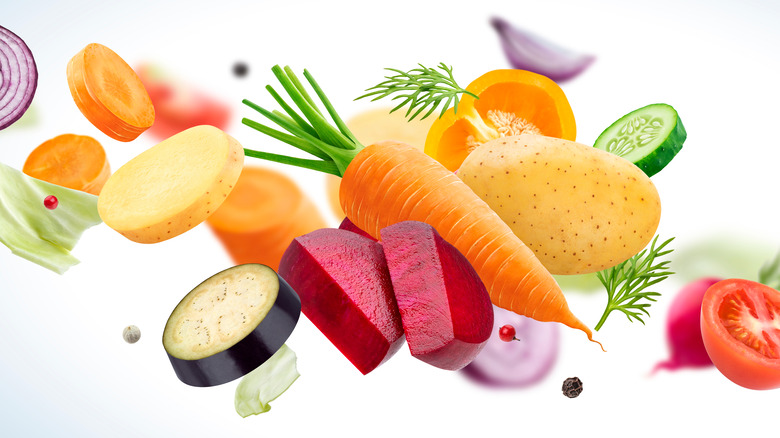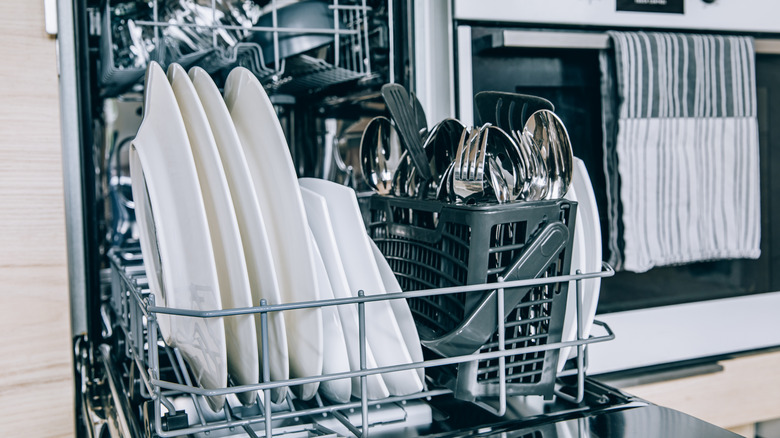10 Tips You Need When Using A Food Processor
From blending to chopping, slicing to julienne, food processors have become an essential kitchen appliance since they were created in 1963. Maybe you use one to prepare every meal or just break it out for dinner parties, or maybe you just bought your first food processor and are totally new to the kitchen appliance. (If you consider yourself one of those first-timers and are not completely sure what to do with your food processor after you plug it in, then let us be the first to welcome you to a world where you can make silky smooth sauces, slice veggies to sublime thinness, or mix up perfectly flaky pie crust in record time — even if it's just a personal record.)
Food processors can work pretty seamlessly, but in order to expect the unexpected, we've compiled a list of 10 important tips that will optimize your food processor experience, improve your recipes, and keep your machine buzzing for years to come. For experienced food processor users and newbies alike, we've got you covered: from whipping up your own nut butters to kitchen safety.
Insert the blade before adding ingredients
Proper assembly is key to ensure your food processor gives you the best results possible and that you stay safe. Most beginners learn the hard way, but one of the most important steps you can take is to load the blade before you fill the container with your food (via Good Housekeeping). The last thing you want is to pack in all your pesto ingredients, snap on your lid, and press the button, only to be met with the buzz of the motor but motionless ingredients. And you can't just open the lid and pop in the blade: The blade fits snuggly on a spindle (or a seat, depending on the model) at the bottom of the container. With all of those ingredients in the way, you risk food getting stuck under the blade and not processing along with the other ingredients, or possibly cutting yourself as try to maneuver or force the blade down.
The best practice is to set up your whole machine on the counter first, before you start prepping your ingredients. The added benefit is that (if you store your food processor in a cabinet) you'll already have all the parts out and set up on your counter, so you're not scrambling to move your mise-en-place with a 12 pound base in one arm.
Pulse, stop, and check your progress
We love food processors because they're extremely powerful and make quick work of chopping ingredients. Still, sometimes fast and powerful gets out of hand. One minute you're preparing tabbouleh that calls for roughly chopped cucumbers and tomatoes, and 30 seconds later at high speed you'd better be in the mood for gazpacho.
The difference is knowing when to pulse or process. Assuming you're using the common S-blade (we'll talk more about blade options later), America's Test Kitchen describes the difference between pulsing — running the processor for short bursts of about one second — or processing — turning the machine on and leaving it on for a certain amount of time. While processing is great for blended foods like sauces and soups, pulsing is a good safety net for anything short of liquefied.
Once you're ready to start chopping, secure the lid and press the pulse button. The machine will automatically pulse on and off in short bursts until you press the button to release. If your machine does not have a specific pulse button, you can simply press and release the on button in one second intervals. Depending on the ingredients and texture you're trying to achieve, periodically open the lid and check inside to see if you've achieved your desired results. If not, close it up and get back to pulsin'.
Scrape down your food processor bowl
Once you've got the hang of pulsing and processing, the next pro-move is scraping down your bowl. Culinary scientist Jessica Gavin details scraping down the bowl as an important way to reincorporate foods that may have gotten stuck. As soon as you turn on your processor, the blade spins, and while it chops it also sends chunks of food flying. Some of these bits get stuck to the wall of the bowl above where the blade reaches, and some may even get lodged under or onto the blade. The majority of ingredients continue to get processed while these stuck pieces are left unincorporated, leaving you with an uneven mix.
To avoid this sad fate, stop processing a little bit before you think you've reached your optimal consistency, take off the lid and (using a rubber spatula or the scraper that came with your food processor) carefully scrape the walls of the bowl in a downward motion to loosen material clinging to the side. If you suspect something is stuck under the blade, use the same spatula and, holding the top of the S-blade spindle in place, wipe under the blades to release any lodged ingredients. If you're worried about prodding around inside with the sharp blade, most food processors have a safety in place where the motor won't run if the lid is not attached, but when in doubt, unplug the machine. Once you've scraped it down, pulse again a few times to reincorporate anything that was formerly stuck.
Grind nuts in your food processor with a bit of flour or sugar
There are few things as annoying as finely chopping nuts for a recipe: they roll all around the counter, their shapes can be irregular and difficult to chop in a uniform manner, they're too hard and shoot out across the kitchen! When you're looking to chop up a large quantity of nuts, or even make a gluten free nut flour, your food processor is an excellent tool. The only hitch is the oil. According to the Mayo Clinic, nuts can be made of up to 80% fat. When you break apart a nut or try to process it, those oils are now exposed. When you grind nuts in your food processor, those oily, finely broken pieces of nuts bump into each other at a high speeds, and some will start sticking and clumping together. Continued processing can result in uneven grinding and a pasty build-up inside your bowl and around the blade.
To avoid this, William Sonoma says to grind nuts with a small amount of flour or sugar. Adding these ingredients will help absorb some of that excess oil, allowing nuts to become more evenly chopped and more easily distributed in batter or dough. Without the help of flour and sugar you could risk ending up with nut butter...
Make nut butters with patience
Making homemade nut butter might be reason enough to buy a food processor if you don't already own one. Silky smooth and customizable, you can add cinnamon, honey, chocolate, cardamom — the flavor options are as plentiful as your imagination. It's almost unbelievably simple, too. Just add some toasted nuts to the food processor and turn it on. The first time you make peanut butter or cashew butter, you'll swear you've done something wrong; five minutes goes by, the nuts are clumping, you scrape down the sides and wonder if you should call it quits. Don't. The final ingredient is patience.
Contrary to processing nearly everything else, with nut butters you want to turn it on and let it ride. In its almond butter guide, Not Enough Cinnamon shows the six stages your nut butter will go through over the course of 10-15 minutes of constant processing. If you notice your food processor motor is becoming hot, stop the machine and let it cool down for 10 minutes or so, then continue processing. You'll know you've reached nut butter perfection when the mixture appears thin and shiny. When you dunk a spoon in you'll see that it's creamy and luxurious.
Use the right size food processor bowl for the job
Like most appliances, food processors come in a variety of sizes (anywhere from one to 14 cup capacity) and it's important to know which size is right for the job at hand. For large projects, make sure you don't overfill your food processor. With liquid foods like soups or sauces, Bon Appétit cautions that overfilling can lead to leaks and you may be better off working in smaller batches. Most bowls have a maximum fill line that is over the height of the blade, and filling past this line with non-liquid ingredients can cause uneven blending as the ingredients below get chopped and the ones above never make it down.
For small jobs, a large food processor is overkill s underfilling a larger machine might be completely ineffective. KitchenSeer warns that if the ingredients are small enough they'll just rest under the blade, undisturbed. If you're making a dry rub spice blend for grilling or a quick salsa for a side dish, a smaller food processor is far more appropriate than the eight or 10 cup one you use for slicing vegetables.
When deciding what size food processor is best for you, MyRecipes recommends that you take a moment to think about how often you cook, what you normally whip up, and your storage limitations. If you find that your cooking activities span a wide range, take a look at the combination processors that offer swappable bowl attachments of different sizes.
Use your food processor to emulsify
Instead of blowing out your biceps whisking up an aioli by hand, have your processor do emulsions. Food processors are excellent when facing nearly super-human tasks like whisking at the speed of light or refining meats. Master Class explains that emulsions are when unlike substances (often water and oils) are dispersed and hold together. This usually involves both substances being broken down into extremely small parts. If one of the parties starts to get together with its friends (oil droplets adhere to other oil droplets) then the emulsion can break. When you've been whisking by hand for nine minutes, whilst slowly dribbling in oil, the last thing you want is for your emulsion to split.
To make a killer emulsified sauce with a food processor, Simply Recipes recommends using the feeder tube insert with a tiny hole at the bottom. While the machine is running, the tube serves as a reservoir and the hole feeds droplets of oil down into the bowl at a steady rate. Before you know it, you'll have a smooth and creamy homemade mayo with no extra wear and tear on those pythons.
Explore different food processor attachments
Often first time food processor owners begin viewing this widely versatile machine as a wide blender — loading up the standard S-blade and chopping up nearly everything. But don't forget that part of the allure of this dynamo is that it is capable of numerous different cuts at speed. It's there to help you achieve your culinary dreams, not limit you to blended soups, sauces, and salsas.
The Kitchn walks you through the numerous attachments and blades that you can explore to help you achieve nearly any dish in your recipe book. Use the shredding disc to make quick work of preparing your signature carrot cake. Trying to cook your grandma's classic potatoes au gratin? Snap on the slicing disc to get perfectly even cuts of the spuds. If you're totally over cutting cold butter into pie crust, the plastic dough blade is there to help. Of course the S-blade will always be there to support you in your times of chopping and grinding need, but when it comes to making time-consuming cuts, take a crack at one of those blades sitting in the cupboard.
Size matters (and so does texture)
Your food processor is great at taking directions: You want it to blend, it blends. Set it to slice, it slices. But be forewarned, it will treat everything you put in there with exactly the same force. To get the most out of your processor it pays off to think about adding ingredients with attention to texture and size.
When making a salsa, soup, dip, or anything with several ingredients that need to be chopped together, The SunSentinel advises you add the firmest ingredients first and work your way over to the softest last. The ingredients that can withstand the most processing before becoming overworked should be in the bowl for the longest, while ingredients that easily become incorporated need the least amount of time. Likewise, if you know you'll be adding an ingredient to the bowl first, you can add it as a bigger piece knowing that it will eventually break down to the size you want after being in the machine for the longest amount of time.
Care for your blade, especially in the dishwasher
Intended to be the work-horse of the kitchen, most food processors are built to withstand a great deal of abuse. For this reason, it can be one of the most overlooked appliances when it comes to care and maintenance. Like any knife edge, the S-blade is only as good as it is sharp; over time and with heavy use, it will become dull. One of the worst mistakes you can make with your food processor blade is to load it into the dishwasher incorrectly. The Kitchn informs us that, while most food processor blades are dishwasher safe, loading them in the bottom of the dishwasher puts them in direct contact with the scalding hot water spray. This can damage the blade and lead to premature wear. To avoid this, always follow manufacturer instructions and load food processor blades and cutting attachments in the upper shelf.
If your blade has become dull, you may not have to buy a whole new replacement just yet. To sharpen your S-blade, TopGearHouse describes a few different methods — from using at home blade sharpeners to common household pantry items like salt or discarded egg shells. The frequency at which you might need to sharpen your blade depends on how often you are using your food processor, but the general recommendation by TopGearHouse is once a year.
